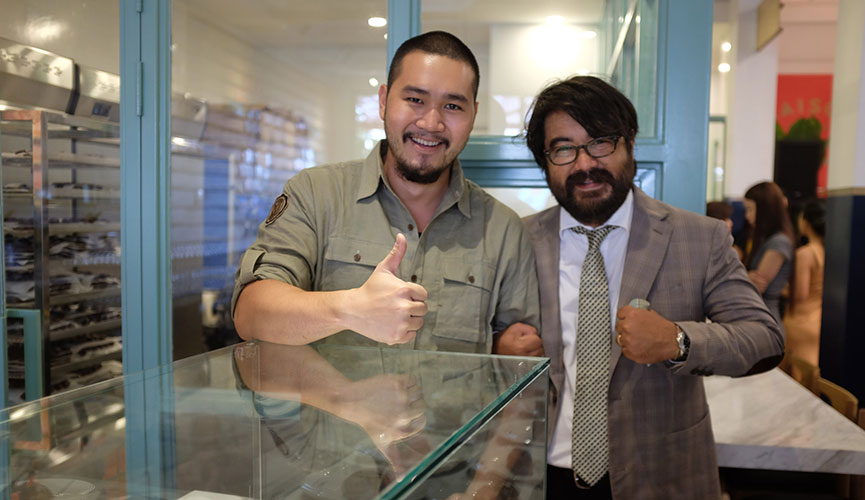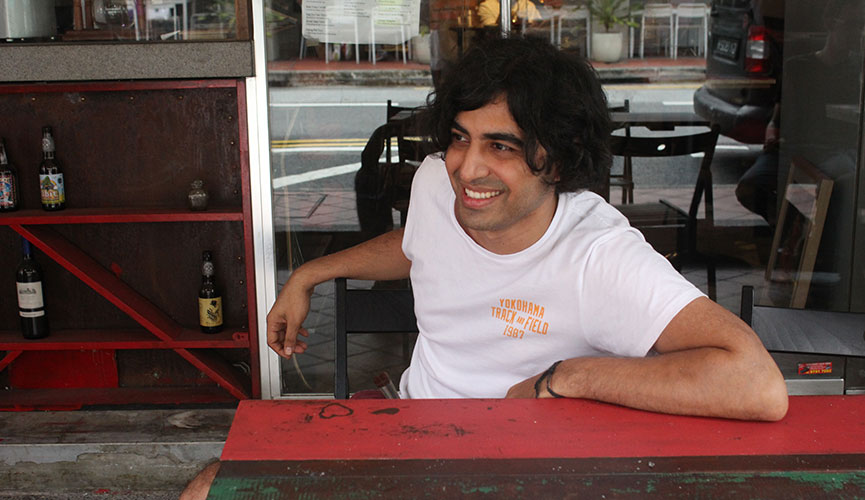But before you start thinking that I just got lucky and adopted a well-behaved dog, think again! I waited a long time for my hubby to agree to having a dog join our family and when it was time for our bundle of fur to come home, I never imagined he would cause me so much stress (and tears)! Once upon a time, Pinot was an unruly, rambunctious adolescent with way too much energy. He jumped on people, he chewed on expensive rugs and iPads, he dragged us down the street on walks, and he bolted out the front door on too many occasions.

Hubby and I obviously needed the help of a dog trainer – pronto! Now this is where I wish I could say that we did our research and engaged a dog trainer who used modern, force-free, reward-based techniques…. but we didn’t. Out of desperation and naivety, we went with a trainer that a friend (who, at that time, was also a new pup parent) was using. Unfortunately, this was a big mistake and one of those things I will always regret – to know that I let Pinot down by not putting his welfare first. You see, not all dog trainers are the same – some trainers use aversive methods and equipment to scare or force dogs into doing what they want them to do. It should have been a red flag when I felt uncomfortable with some of the ‘moves’ I was asked to do on Pinot but I ignored it because he was an ‘expert’ and I was, after all, seeing results, even though they were short term.
Less than a month after we were done with our training sessions, behavioural challenges started to emerge in Pinot. It was very stressful at home and I was at my wits’ end. But this time, I did what I should have done in the beginning. I got online and researched and read, and researched some more. That’s when I found Dr. Nee Kang (PhD, CPDT-KA) of cheerfuldogs.com. Nee is an animal behaviourist, scientist and certified professional dog trainer with an extensive list of qualifications against her name. She provides canine behaviour consultation, basic obedience classes, and behaviour modification programmes.
Nee is a proponent of dog-friendly, low stress handling techniques. From the moment I received her first email reply in response to the challenges I was facing with Pinot, she gave me confidence (and hope) that we could get through it together. During the two months we worked under Nee’s patient and encouraging guidance, she provided me with the skills to communicate effectively with Pinot, and showed me that when you use humane training techniques, you and your dog can achieve anything together while having fun. And for the first time since I adopted Pinot, I was finally bonding with him. I will always be grateful to Nee for giving me the tools to help Pinot blossom into the amazing dog that he is. She inspired me to keep learning together with Pinot and today, I’m still teaching Pinot ‘frivolous’ tricks – just for the fun of it – using the same techniques she taught me six years ago.

So how do you navigate through the minefield of dog training options? Nee tells us more about herself and provides us with some great advice.
What is your background and what inspired you to become a dog trainer?
As with many dog lovers, I wanted to be a vet when I was young. My parents couldn’t afford to send me overseas to study veterinary science, so I became a scientist instead. My PhD research centred on bird behaviour and ecology. I would have loved to have been able to do the exciting work in canine cognition and behaviour that is now being done with dogs, but in those days, it was more popular to study wild animals, not domesticated ones. But becoming a scientist gave me a better understanding of nature, animal behaviour, and their links to us.
Working with dogs has always been in my blood – I may have taken a detour or two, but it seems to have come full circle. As a dog trainer, I personally think that I straddle the best of both worlds – the knowledge and skills of a scientist so that I can better evaluate the flood of information and myths about dog training that’s out there, and the ability to translate those skills and knowledge into practical solutions for dog guardians. There are many dogs and humans out there who need help understanding each other – I’m simply here to help that process.

There are so many different dog training techniques out there. What is your training philosophy?
“Do No Harm” would summarise my training philosophy – I train dogs and humans without the use of force, without causing fear, without invoking the outdated view of pack leadership or dominance. Instead, the focus is to be proactive – teach your dog what you’d like it to do, pay it well for making these good choices, and learn to become an expert in reading your dog’s body language so that you can tell if it’s enjoying, tolerating or is stressed by the situations that you’ve put your dog in. When you can read your dog that way, it becomes more obvious what you can do when hiccups occur in that relationship. When you adopt a proactive, rather than a reactive approach to educating your dog, you’ll find that it becomes second nature, and it strengthens the relationship you have with your dog.

What advice would you give someone looking for a dog trainer? What should they be aware of?
Professional qualifications and skills (or lack of), training philosophy and techniques, compassion, empathy and humility are important. As a certified professional dog trainer, continuing education is key to me – by staying current with best practices, I build my trainer toolkit so that I can become a better trainer, to help more dogs and people.
The dog care industry in Singapore is unregulated, which means, anyone who has ever taught a dog to sit by whatever means, can set up a dog training business and call themselves a dog trainer, a dog specialist, a dog behaviour counsellor, a dog behaviour consultant, a dog behaviourist, and so on – often without the proper qualifications.
You wouldn’t see an unqualified doctor or seek legal advice from someone who’s not a lawyer. So why would you have your dog trained by someone who has not put in the time, resources and work to obtain credible and reputable professional qualifications?

So check the trainer’s credentials and ask yourself: is he a qualified professional, where did he obtain his training experience, how current is he with evidence-based training, are you comfortable with how he handles and trains your dog, was your dog comfortable with the trainer, was he able to help you address your concerns (with empathy for you and your dog).
Also, a great trainer won’t just have a one size-fits-all solution for you – every dog is an individual and deserves bespoke training.
If there’s one thing you want people to understand about training, what would that be?
For dog guardians, you have a choice. You can choose to train your dog well, without using force, and bask in the joy knowing that you are communicating with each other, that your dog is enjoying the experience, and that you are building a relationship and becoming a team with your dog. Or, you can choose to train your dog using aversive tools that can potentially harm your dog and its relationship with you in the long-term, but seem to give short-term results. Whichever it is, there are consequences to the choice you make – for better or for worse.

You’re working on a number of programmes with the Society for the Prevention of Cruelty to Animals (SPCA) in Singapore. Tell us more about that.
SPCA is committed to raising the standards of dog handling and training, and supports force-free training and low stress handling approaches that are ethical and have a positive impact on animal welfare. This is wonderful as it means we’re aligned in our long-term goals, even if we don’t get there in one giant step, but have to take many puppy steps along the way. Some of these puppy steps are programmes that I’ve conducted, e.g. staff and volunteer training workshops, dog behaviour workshops for the public, and public talks at specific events.
One programme that I’m particularly fond of is The Dog Mentorship Project. I have a team of about 20 volunteers, who started off as dog walkers, but now serve as Dog Mentors to specific dogs with behavioural challenges. The Dog Mentors are students, working adults, and expats who work with their Mentees almost as if these Mentees were their own dogs. They learn their handling skills with me, we trouble-shoot the challenges and try to find ways to provide behavioural enrichment for these dogs for the duration of their stay at the shelter. We can’t solve all the problems, but we try our best to make the lives of these dogs less stressful, as much as we can.
Do you have a ‘trainer tip’ to leave us with?
- Understand your dog – become an expert in reading his behaviour so you can address issues before they become serious.
- Communicate with your dog in ways that he can understand – remember that English is not your dog’s first language.
- Reward your dog – when you do that, you take the stress out of the learning process for you and your dog, and it strengthens the behaviours that you want to see more of, and
- Bond with your dog – when you can do the above, you’re well on your way on that journey that will see your dog through its life with you.

For more information on Dr. Nee Kang and cheerfuldogs.com:
www.cheerfuldogs.com
Email: kangnee999@yahoo.com
Facebook: cheerfuldogs.com
Instagram: cheerfuldogs
Images provided by Cheerful Dogs with photographer as credited. Feature image by Darren Yau.
This article was originally published on www.ordinarypeople.ink and may have been edited for this platform.




